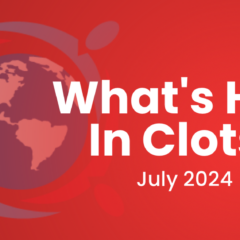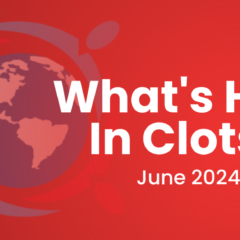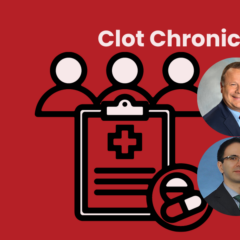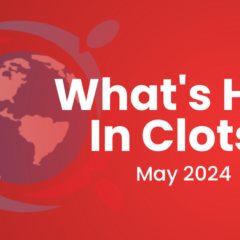Last updated on
Trial Tidbits: ESC 2020
The European Society of Cardiology hosted their first-ever virtual 2020 Congress from August 29 to September 1. Here’s a handy guide to some of the big thrombosis-related trials you might have missed.
EAST-AFNET 4
Participants
- 2,789 patients with recently diagnosed* atrial fibrillation (AFib) and an average CHA2DS2-VASc** score of 3.4
*Recently diagnosed = diagnosis within ≤1 year before study enrollment ** CHA2DS2-VASc risk score
Trial Design
- International, prospective, blinded-outcome-assessment trial
- Patients randomly assigned to either:
- An early rhythm-control strategy with an antiarrhythmic medication or ablation
- Usual care with rate-control therapy (in a minority of patients, rhythm-control therapy only initiated to mitigate uncontrolled AFib symptoms with adequate rate control)
- Median 5.1-year follow-up
Study Endpoints
- Co-primary endpoint 1: Composite of cardiovascular (CV) death, stroke, acute coronary syndrome, or hospitalization for worsening heart failure (HF)
- Co-primary endpoint 2: Mean number of nights spent in the hospital each year (a measure to approximate the cost of treatment)
- Primary safety endpoint: Stroke, death, or serious adverse events related to rhythm-control therapy
Key Findings
- The primary outcome occurred at a rate of 3.9% each year in the rhythm-control group compared to 5% per year in the rate-control group, resulting in a statistically significant 21% relative risk reduction in favor of early rhythm control.
- Results appeared consistent across predefined subgroups (i.e., asymptomatic patients, patients with obesity, and patients with or without HF).
- The mean number of nights in the hospital was roughly the same in both arms (about 5 days/year).
- The primary safety outcome didn’t differ between groups, but serious adverse events were more common in the rhythm-control group (4.9% vs. 1.4%), translating to about a 1% serious event rate annually in the rhythm-control group.
- More than 70% of patients in both treatment groups were asymptomatic at 1 and 2 years, suggesting that both rate and rhythm control can help mitigate symptoms in patients with early AFib.
Study Limitations
- Open trial design
- Not designed to evaluate the safety or effectiveness of specific components of early rhythm control
- Results may not be generalizable to patients who initiate rhythm-control therapy later in AFib course
The Bottom Line
- Early rhythm-control therapy can play an important role in managing patients with early AFib at risk of CV complications.
Corresponding Publication: Kirchhof P, Camm AJ, Goette A, et al. N Engl J Med. 2020. DOI: 10.1056/NEJMoa2019422.
LoDoCo2
Participants
- 5,522 patients with chronic coronary disease
- Most patients treated with secondary prevention therapies at baseline (e.g., antiplatelet agents or anticoagulants, statins, beta-blockers, etc.)
Trial Design
- International, double-blind trial
- Half of patients received 0.5 mg of colchicine once daily and half received a matching placebo
- There was a 30-day run-in period for tolerance (no loading dose)
- Median 28.6-month follow-up
Study Endpoints
- Primary endpoint: Composite of CV death, spontaneous (nonprocedural) myocardial infarction (MI), ischemic stroke, or ischemia-driven coronary revascularization
- Secondary endpoints (ranked in order):
- CV death, MI, or ischemic stroke (key secondary endpoint)
- MI or ischemia-driven coronary revascularization
- CV death or MI
- Ischemia-driven coronary revascularization
- MI
- Ischemic stroke
- Death from any cause
- CV death
Key Findings
- The primary endpoint occurred in 6.8% of the colchicine arm compared to 9.6% in the placebo arm, resulting in a 31% lower risk and 77 fewer events in patients taking colchicine vs. placebo.
- Colchicine benefits were also observed in several of the secondary endpoints, including MI and ischemia-driven coronary revascularization.
- Non-CV death was significantly higher with colchicine compared to placebo (0.7 vs. 0.5 events per 100 person-years).
Study Limitations
- C-reactive protein or other inflammatory markers not routinely measured at baseline
- BP and lipid levels not collected at baseline or during trial
- Small percentage of female participants
The Bottom Line
- These findings were consistent across subgroups and build on evidence from previous trials (LoDoCo and COLCOT) supporting the potential benefits of anti-inflammatory treatments in patients with coronary disease.
Corresponding Publication: Nidorf SM, Fiolet ATL, Mosterd A, et al. N Engl J Med. 2020; DOI: 10.1056/NEJMoa2021372
HOME-PE
Participants
- 1,974 patients presenting to the emergency department (ED) with non-high-risk (hemodynamically stable) pulmonary embolism (PE)
Trial Design
- International, open-label, noninferiority trial
- Half of patients randomized to risk stratification with the HESTIA* rule
- The other half randomized to risk stratification with the simplified Pulmonary Embolism Severity Index (sPESI)** score
- Low-risk patients discharged home; patients not deemed low risk were hospitalized
Study Endpoints
- Primary endpoint: All-cause death, recurrent venous thromboembolism (VTE), or major bleeding at 30 days
- Secondary endpoints: Proportion of patients managed as outpatients, the rate of low-risk patients eligible for outpatient care, cumulative event rate, and rates of recurrent VTE, suspected recurrent VTE, major bleeding, nonmajor bleeding, death, and serious adverse events
Key Findings
- Nearly 40% of patients in the HESTIA group were eligible for outpatient care (“no”answers to all 11 criteria); nearly half of sPESI-scored patients had a score of 0 and were deemed eligible for outpatient management.
- Physicians could overrule the discharge decision; 38% of patients were discharged home within 24 hours in the HESTIA group and 37% in the sPESI group.
- The primary endpoint occurred in:
- 3% of the HESTIA outpatients vs. 1.1% of the sPESI outpatients.
- 6% of the HESTIA hospitalized patients vs. 4.7% of the sPESI outpatients.
Study Limitations
- Successful outpatient management depends on access to healthcare and social support (not examined in the study)
- Role of additional imaging or laboratory criteria to exclude more severe PE was not addressed
The Bottom Line
- In patients with PE, the HESTIA rule was noninferior to the sPESI score regarding all-cause death, recurrent VTE, or major bleeding. The two strategies didn’t differ as far as the proportion of patients treated at home.
- Risk stratification can identify approximately one-third of low-risk PE patients that can be safely managed at home.
Reference: Presented by Dr. Pierre-Marie Roy at the European Society of Cardiology Virtual Congress, August 31, 2020.
IMPACT-AFib
Participants
- >47,000 patients with AFib and a CHA2DS2-VASc score of at least 2 who had not initiated oral anticoagulation (OAC)
Trial Design
- US-based, prospective, randomized, open-label educational intervention trial
- Half of patients received a single educational mailing at the start of the trial and half received usual care
- The mailing included:
- A letter about the patient’s AFib diagnosis
- A statement about why OAC is a suitable medication option
- A suggestion that patients discuss OAC with their healthcare provider
- Additional components of the mailing included information on stroke risk in AFib, a chart to manually calculate one’s CHA2DS2-VASc score, and an overview of the potential risks of OAC, possible drug-drug interactions, and the limited availability of reversal agents
Study Endpoints
- Primary endpoint: The proportion of patients initiating OAC within 1 year of follow-up
Key Findings
- Nearly 10% of patients in both study arms began OAC within 1 year of follow-up (9.89% and 9.80% in the intervention and usual care groups, respectively; OR, 1.01, 95% CI 0.95-1.07).
- There was a non-statistically significant numerical uptick in patients starting OAC early after the mailing.
Study Limitations
- The mailing did not overtly address the benefits of OAC in patients with AFib.
The Bottom Line
- OACs remain under-prescribed and underused in patients with AFib.
- A single mailing/intervention is likely inadequate to capture attention and change patient behavior. Repeated messaging or multi-component interventions targeting both patients and providers may yield better outcomes.
Reference: Presented by Dr. Sean Pokorney at the European Society of Cardiology Virtual Congress, September 1, 2020.
Additional studies you may be interested in:
- The POPular TAVI trial: In patients not taking OAC, aspirin alone vs. aspirin + clopidogrel following transcatheter aortic valve implantation (TAVI) significantly reduced bleeding rates and did not increase thromboembolic events.
- The EMPEROR-Reduced trial: Patients receiving recommended therapy for HF who also received empagliflozin had a lower risk of CV death or hospitalization for HF, regardless of their diabetes status.
- The DAPA-CKD trial: Dapagliflozin prolonged survival and significantly reduced the risk of kidney failure, HF hospitalization and CV death in patients with CKD regardless of their diabetes status
Consumer-friendly trial summaries can be found at the ACC Media Center:



